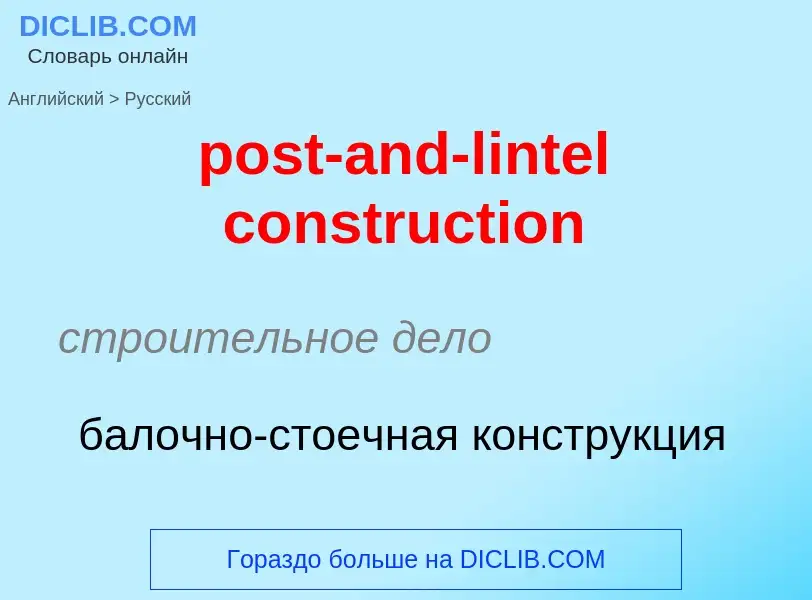Перевод и анализ слов искусственным интеллектом ChatGPT
На этой странице Вы можете получить подробный анализ слова или словосочетания, произведенный с помощью лучшей на сегодняшний день технологии искусственного интеллекта:
- как употребляется слово
- частота употребления
- используется оно чаще в устной или письменной речи
- варианты перевода слова
- примеры употребления (несколько фраз с переводом)
- этимология
post-and-lintel construction - перевод на русский
строительное дело
балочно-стоечная конструкция
балочно-стоечный каркас
['treibi(e)it]
синоним
[treibi'eiʃ(ə)n]
архитектура
антаблемент
балочное перекрытие
существительное
архитектура
антаблемент
балочное перекрытие
['treibieitid]
архитектура
с балочным перекрытием (построенный)
строительное дело
балочно-строечный (о здании)
с антаблементом
прилагательное
архитектура
(построенный) с балочным перекрытием
общая лексика
строительный мусор
общая лексика
строительный мусор
Определение
Википедия

In architecture, post and lintel (also called prop and lintel or a trabeated system) is a building system where strong horizontal elements are held up by strong vertical elements with large spaces between them. This is usually used to hold up a roof, creating a largely open space beneath, for whatever use the building is designed. The horizontal elements are called by a variety of names including lintel, header, architrave or beam, and the supporting vertical elements may be called columns, pillars, or posts. The use of wider elements at the top of the post, called capitals, to help spread the load, is common to many traditions.
The trabeated system is a fundamental principle of Neolithic architecture, ancient Indian architecture, ancient Greek architecture and ancient Egyptian architecture. Other trabeated styles are the Persian, Lycian, Japanese, traditional Chinese, and ancient Chinese architecture, especially in northern China, and nearly all the Indian styles. The traditions are represented in North and Central America by Mayan architecture, and in South America by Inca architecture. In all or most of these traditions, certainly in Greece and India, the earliest versions developed using wood, which were later translated into stone for larger and grander buildings. Timber framing, also using trusses, remains common for smaller buildings such as houses to the modern day.
The biggest disadvantage to a post and lintel construction is the limited weight that can be held up, and the small distances required between the posts. Ancient Roman architecture's development of the arch allowed for much larger structures to be constructed. The arcuated system spreads larger loads more effectively, and replaced the post and lintel trabeated system in most larger buildings and structures, until the introduction of steel girder beams in the industrial era. As with the Roman temple portico front and its descendants in later classical architecture, trabeated features were often retained in parts of buildings as an aesthetic choice. The classical orders of Greek origin were in particular retained in buildings designed to impress, even though they usually had little or no structural role.







.jpg?width=200)
